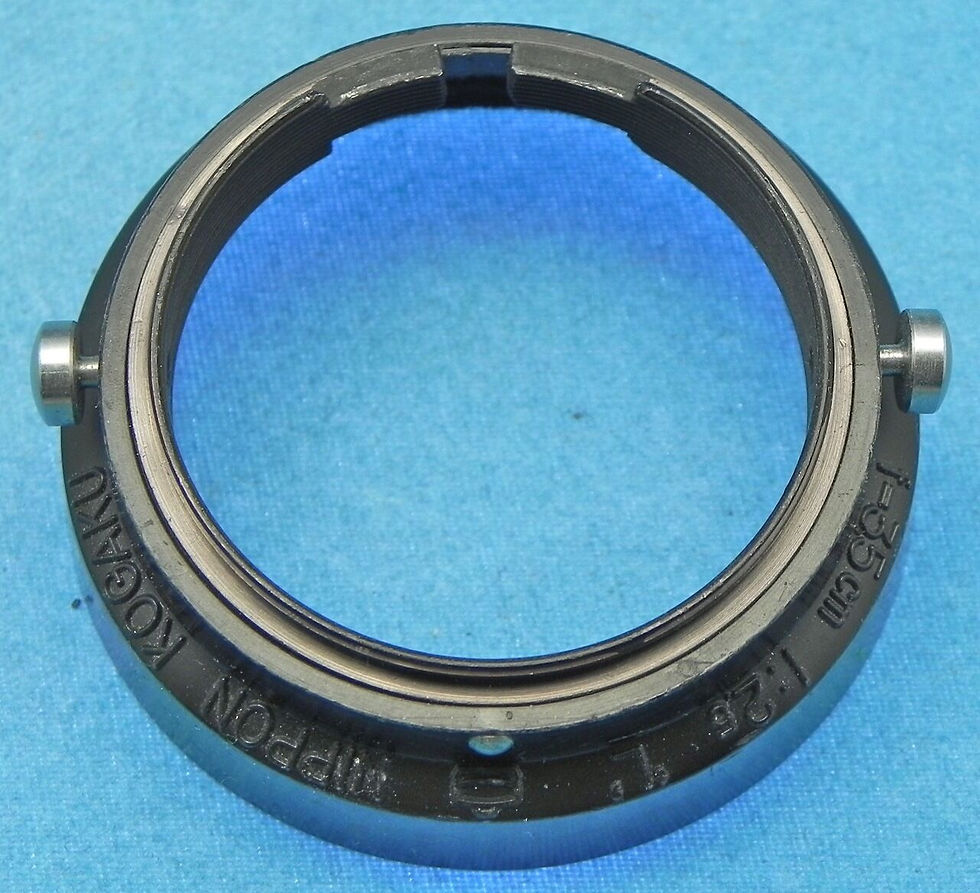
Nikkor-W 2.5cm F4
The Nikkor 2.5cm F4 lens's optical design was the sole work of Mr. Hideo Azuma, finalized in the autumn of 1953. Following this, a prototype lens was produced for testing, and the blueprints for mass production were authorized in September 1954. Upon scrutinizing the intricate details of this lens, its magnificence becomes evident. Notably, the two concave elements possess a mere thickness of 0.45mm. The curvature radius approaches hemispherical, and the variance in curvature radius between the front and rear elements is exceptionally slight. Additionally, the blueprints include a notation stipulating that the lens's decentering should not exceed 60 seconds of tolerance. The fabrication of these lens elements must have posed formidable challenges. Scaling down in size is a profoundly demanding endeavor, entailing tolerances one-tenth as tight, or accuracy elevated by a factor of ten compared to the norm.
Concerning this lens system, reports indicate that the manufacturing division faced considerable difficulties, not only in terms of processing but also in the realm of production. Managing the delicate concave lenses proved arduous. Conventional air blowers were unsuitable for dust removal. The use of alcohol for cleaning was precluded. Excessive force could not be applied to the lens. Even blowing air with a gun-like device risked fracturing or displacing the lens. Cleansing with alcohol risked breakage due to the temperature fluctuations caused by evaporation. Consequently, a specialized cleaning apparatus fashioned from feathers was reportedly employed for the lens. The lens proved to be exceptionally challenging on the factory floor. Nonetheless, the dedicated workers in the production area surmounted these adversities, concentrating their efforts on realizing the lens. In doing so, they experienced a deep sense of pride and commitment, fueled by the realization that they were contributing to the creation of the illustrious Nikkor lens.
Take a moment to examine the cross-sectional view of the lens. The Topogon-type lens is composed of four elements, arranged as convex-concave-concave-convex from the left. Nestled at the heart of this circular lens system is a diaphragm, creating a symmetrical configuration. In essence, when the Topogon-type lens is envisioned with a configuration of convex (concave, concave) and convex elements, it presents a triplet design distinct from the Hypergon. This implies that the lens possesses the capacity to correct SEIDEL's five aberrations and two chromatic aberrations.
Upon meticulous examination of the lens's aberration characteristics, many individuals held the impression that even the Nikkor lens might not deliver the desired imaging attributes due to its Topogon-type design. However, upon evaluating actual photographs, this perception was proven incorrect. Undoubtedly, owing to the lingering presence of residual spherical aberration and incompletely rectified coma, a slight flare becomes noticeable close to the nearest focal point when the lens is employed at its maximum aperture. This results in images that exude a gentle impression rather than a stark sharpness. Nevertheless, this lens yields a moderate level of resolution accompanied by a harmonious blend of natural contrast and perspective.

Nikkor-W 2.5cm F4: S-mount vs Leica thread Screw Mount
Nikon manufactured a total of 2,874 units of this lens, with 1,924 units featuring the Nikon S mount and 950 units utilizing the screw mount. The Nikon S mount can technically be adapted to the Leica M system using an S-M adapter, but Nikon's design makes it exceedingly challenging to achieve accurate focus on the Leica system.
The initial version of the S-Mount lens was available in chrome-on-brass mount, weighing 125 grams as per Robert Rotoloni's reference. Subsequently, a lighter black version was introduced, weighing 88.85 grams. It's worth noting that, despite its compact size, the Leica version of the lens was the heaviest, weighing in at 133.56 grams, owing to the inclusion of a helicoid mechanism. This design characteristic ensures optimal functionality.
The lens features an unusual filter size of 34.5mm, which can be surprisingly difficult to find. The hood designed for the Leica version was manufactured from metal and utilized a screw-in design. In contrast, the S-Mount Lens was designed with a two-pin type hood mount, which restricts compatibility to specialized two-pin filter ring, two-pin hood, as well as two=pin lens cover. However, it's worth noting that both iterations of the hoods are characterized by their scarcity and consequently demand premium prices in the market. This high value is largely attributed to their inclination to detach easily for S-Mount version, adding to their sought-after nature among collectors and enthusiasts.










photo extracted from The Complete Nikon Rangefinder System by Robert J. Rotoloni


Type 5: OLJ's Lens Hood for Nikkor 2.5cm F4 LTM
In my opinion, the appearance of the Nikon Lens Hood for the 2.5cm F4, Nikon designed for both S-Mount and Leica Thread, is not appealing. Additionally, I have been unsuccessful in locating any authentic mint Nikon hoods on platforms like eBay or Yahoo Japan Auctions, When these hoods do appear in auctions, the prices are exorbitant (e.g. . I have also explored options from third-party manufacturers, but unfortunately, their designs do not meet my aesthetic standards. As a result, I have opted to create a custom lens hood that aligns with my vision of how it should look. With a little help from me, this particular lens hood was drafted and designed by my second son, Christopher Zee (Mitsutaka Jo) who is 17 years old in 2023. It is a ventilated hood with 5 vents, crafted, and black painted in Japan.
The Type 5 with 34.5mm diameter filter size will fit on 1) Nikkor 2.5cm F4 LTM, 2) Nikkor 2.8cm F3.5cm LTM, 3) Nikkor 3.5cm F2.5 LTM, 4) Nikkor 3.5cm F3.5cm LTM, 5) Nikkor 5cm F3.5 Micro S-mount, 6) Nikkor-T 10.5cm F4 S-mount.















